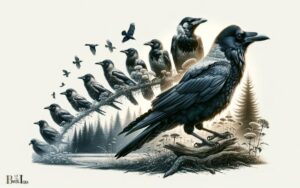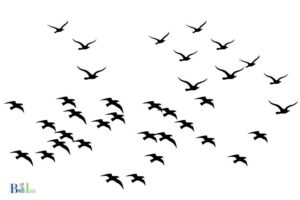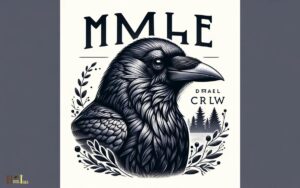What Is a Group of Crows Called: Murder!
A group of crows is commonly referred to as a ‘murder.’
The term ‘murder’ for a group of crows is steeped in folklore and has a dramatic flair that captures the imagination.
It is one of the many colorful and historical collective nouns for animals, which were popularized during the Middle Ages.
This term may have originated from the symbolic association of crows with death or from the noisy, seemingly conspiratorial nature of these birds when gathered together.
Despite its grim connotations, the term ‘murder’ adds a layer of intrigue to the communal aspect of crows, highlighting the rich tapestry of language connected to the animal kingdom.
The term ‘murder’ is used to describe a group of crows, a collective noun that evokes a sense of mystery and intrigue.
This article examines the etymology and cultural context behind this expression, as well as the intriguing social behavior of crows.
Discover the historical backdrop and the captivating collective terms that enrich our language and provide insight into these intelligent avians, as we reveal the enigmatic name given to a congregation of crows.
Key Takeaway
The Basics of Crow Group Terminology
A group of crows is formally referred to as a ‘murder.’ Crows are highly intelligent and social birds, and their group name reflects a sense of mystery and intrigue. When crows gather in large numbers, it can indeed look like a scene out of a suspenseful movie.
This fascinating terminology adds to the allure of these creatures, as they are often associated with symbolism in various cultures. The collective noun ‘murder’ for crows is an example of the rich and evocative language that describes the natural world.
Understanding the terminology associated with animal groups not only adds depth to our language but also allows us to appreciate the nuances of the animal kingdom.
Now, let’s delve into the historical and cultural significance of crows and their group dynamics.
Historical and Cultural Significance
Crows have held significant roles in various cultures and historical contexts. From being symbols of wisdom and intelligence in folklore to serving as omens and superstitions in different societies, crows have played a prominent role in human beliefs and traditions.
Additionally, crows have been featured prominently in mythology, often representing different entities and carrying various symbolic meanings.
Symbolism in Folklore
The symbolism of crows in folklore holds significant historical and cultural significance.
Across various cultures, crows have been associated with both positive and negative symbolism.
In some folklore, crows are seen as messengers of the gods or ancestors, bringing wisdom and guidance to those who pay attention to their presence.
However, in other cultures, crows are seen as omens of bad luck or even as symbols of death and the underworld.
In Native American folklore, crows are often viewed as tricksters, bringing both chaos and wisdom.
The rich and varied symbolism of crows in folklore reflects the complex and diverse ways in which human societies have interpreted and interacted with the natural world.
These interpretations provide insight into the human psyche and the universal themes of life, death, and the unknown.
Superstitions and Omens
In many cultures throughout history, superstitions and omens surrounding crows have held significant historical and cultural significance.
Crows have been both revered and feared, often associated with magic, mystery, and the unknown.
In some cultures, a crow flying over a house is considered an omen of death or bad luck, while in others, it is seen as a sign of good fortune or protection.
The appearance of crows during certain events or at specific times has been interpreted as foretelling the outcome or direction of those events.
Additionally, the behavior of crows, such as their calls or movements, has been believed to convey messages or warnings.
These superstitions and omens have played a role in shaping cultural practices, rituals, and belief systems in various societies, reflecting the enduring impact of crows on human consciousness.
Crows in Mythology
Throughout history, crows’ historical and cultural significance in mythology has been marked by their portrayal as enigmatic and influential figures.
- Mystery: Crows have been associated with mystery and the unknown, often serving as symbols of magic and hidden knowledge in various mythologies.
- Intelligence: Many cultures view crows as highly intelligent creatures, capable of outsmarting humans and other animals, leading to their portrayal as cunning and wise beings.
- Death and Transition: In some mythologies, crows are linked to death and the afterlife, symbolizing the transition between life and the spirit world.
- Freedom: Crows are often depicted as symbols of freedom and independence, embodying the untamed spirit of the natural world, resonating with those who desire liberation from societal constraints.
Collective Behavior and Communication
When examining the collective behavior and communication of crows, it becomes evident that these birds rely on a diverse array of communication methods, including vocalizations, body language, and even the use of tools.
Moreover, the social behavior of crows within a group showcases a complex hierarchy and cooperative tendencies, which are essential for their survival and success as a species.
Understanding these aspects of crow behavior provides valuable insights into the fascinating dynamics of these intelligent and social birds.
Crow Communication Methods
Crow communication methods are crucial for the collective behavior and coordination within a group of crows.
Their communication is both complex and essential for their survival and success as a group.
Here are some key methods they use to communicate:
- Vocalizations: Crows use a wide range of calls to convey different messages, from warning of danger to indicating a food source.
- Body Language: They communicate through various physical movements and postures, such as head bobbing, wing flapping, and tail spreading.
- Gathering: Crows often come together in large numbers at a roosting site, using this as an opportunity to exchange information and coordinate their activities.
- Intelligence: Their ability to problem-solve and learn from one another also serves as a form of communication, allowing for the transmission of knowledge within the group.
Social Behavior in Crows
Social behavior in crows is characterized by a sophisticated system of communication and collective coordination, essential for their survival and success as a group.
Crows engage in complex social interactions, often forming large flocks to forage, roost, and defend territories.
Their communication methods extend beyond vocalizations to include visual displays, such as posturing and movement patterns.
Collective behavior in crows is evident during mobbing, where they cooperate to repel predators or intruders.
Additionally, crows have been observed using tools collaboratively, showcasing their ability to learn from one another.
Their social structure is not rigid, allowing for flexibility and adaptability in response to changing environmental conditions.
This communal nature enables crows to share information, resources, and protection, contributing to their resilience and widespread distribution.
Common Misconceptions About Crow Groups
Despite being often portrayed as omens of death and darkness, groups of crows are actually highly intelligent and social creatures.
However, there are common misconceptions about crow groups that perpetuate negative stereotypes.
Let’s debunk these myths:
- Misconception: Crows only gather to feed on carcasses.
- Reality: Crows form groups for socializing, roosting, and protection.
- Misconception: Crow groups are aggressive and menacing.
- Reality: Crows exhibit complex communication and cooperation within their groups.
These misconceptions often stem from superstitions and folklore, but they fail to capture the true nature of these remarkable birds.
Understanding the reality behind these misconceptions can help foster a deeper appreciation for the fascinating behaviors of crow groups.
Now, let’s explore the unusual and lesser-known terms associated with groups of crows.
Scientific Insights Into Crow Gatherings
Scientific research provides valuable insights into the behavior and dynamics of crow gatherings.
Understanding the intricacies of these gatherings can evoke a sense of wonder and appreciation for the natural world.
Here are four compelling findings that shed light on the fascinating nature of crow gatherings:
- Intelligence: Crows are highly intelligent birds, capable of problem-solving and complex social interactions.
- Communication: Research has shown that crows have sophisticated communication systems, allowing them to convey specific messages within their groups.
- Social Structure: Studies reveal that crow gatherings exhibit intricate social structures, with hierarchies and cooperative behaviors.
- Adaptability: Crows demonstrate remarkable adaptability to changing environments, showcasing their resilience and freedom in the wild.
These insights invite us to marvel at the freedom and adaptability of these intelligent creatures in their natural gatherings.
What Is The Collective Noun For Crows?
The collective noun for a group of crows is commonly referred to as a “murder.” The term “murder of crows” has been in use for centuries and is rooted in historical and poetic associations rather than any scientific basis.
Collective nouns are a fascinating aspect of the English language, often derived from historical usage, literature, or folk traditions.
The origin of the term “murder” for a group of crows is not definitively known, but it likely stems from the birds’ perceived association with death and their scavenging habits around carrion.
Crows have been historically depicted as ominous or mysterious birds in various cultures, and their presence at battlefields or scenes of death may have contributed to the association.
It’s worth noting that while “murder” is the most well-known collective noun for crows, there are alternative terms such as a “horde of crows,” “parliament of crows,” or even a “congress of crows.”
However, “murder” remains the most widely recognized and commonly used term. These alternative names often arise from linguistic playfulness, with people inventing creative and whimsical collective nouns for different groups of animals.
Conclusion
The collective noun for a group of crows is a ‘murder,’ which adds an air of mystery and intrigue to these intelligent and social birds.
Through their historical and cultural significance, as well as their complex communication and behavior, crows continue to fascinate and captivate us.
By delving into the scientific insights and lesser-known terms associated with crow groups, we gain a deeper understanding of these enigmatic creatures and their fascinating gatherings.






